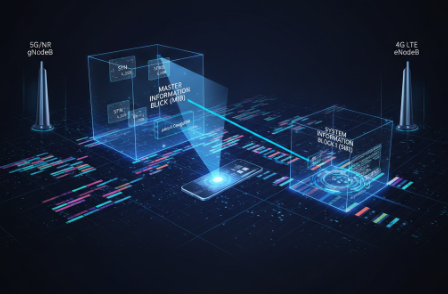
The Master Information Block (MIB) Explained: An Engineer’s Guide to LTE vs. 5G NR
A User Equipment (UE) powers on. It has no network, no connection, and no information. What is the very first piece of data it looks for to understand the network around it? The Master Information Block. This is the “hello, world” of a cellular network.
The MIB is the most fundamental piece of system information broadcast by a cell. It’s the gateway for a UE to even begin the connection process, known as initial access.
This guide will provide a deep, technical breakdown of the MIB. We will go beyond a simple definition to explore the exact parameters in both 4G/LTE and 5G/NR, explain how the MIB is transmitted, and detail the critical (and often misunderstood) difference in how 5G’s MIB acts as a “pointer” to find SIB1.
What is a Master Information Block (MIB)?
The “Digital Welcome Mat”: MIB’s Role in Initial Access
Think of the MIB as the digital welcome mat for a cellular network. It’s the first step in the “cell search” procedure, which a UE decodes right after finding the PSS/SSS (Primary and Secondary Synchronization Signals).
It provides the absolute minimum information needed for the UE to proceed. The MIB is not the whole phone book—that’s the System Information Blocks (SIBs). Instead, the MIB is the small note that tells you where to find the phone book.
How the MIB is Transmitted (MIB, SIB, & PBCH)
In the Radio Resource Control (RRC) protocol, channel mapping is key. The MIB itself is carried by the BCCH (Logical Channel), which maps to the BCH (Transport Channel), which finally maps to the PBCH (Physical Broadcast Channel).
The MIB’s entire purpose is to be the gateway to SIB1 (System Information Block 1). You must decode the MIB to find SIB1. This entire process is strictly defined by the global standards, ensuring any compatible UE can connect to any network.
[3GPP TS 36.331 (LTE) and 38.331 (5G NR) specifications]
The 4G/LTE MIB: Key Parameters & Function
In 4G/LTE, the Master Information Block is simple and direct. It’s broadcast by the eNodeB (the 4G base station) and gives the UE fixed information about the cell’s basic configuration.
Decoding the LTE MIB: A Parameter Breakdown
The LTE MIB contains three critical pieces of information:
dl-Bandwidth: This tells the UE the channel bandwidth (e.g., 5, 10, 15, or 20 MHz).phich-Config: This defines the configuration for the PHICH (Physical Hybrid ARQ Indicator Channel), which carries the ACK/NACK (acknowledgment/negative-acknowledgment) for uplink data.systemFrameNumber (SFN): This provides the 8 most significant bits (MSBs) of the 10-bit System Frame Number. The UE can determine the 2 least significant bits (LSBs) from the MIB’s 40ms scheduling cycle.
How the LTE MIB is Transmitted by the eNodeB
The LTE MIB’s transmission is rigid and predictable:
- Location: It is always transmitted in the central 6 Resource Blocks (RBs) of the downlink bandwidth. This fixed location makes it easy for any UE to find.
- Periodicity: A new MIB is broadcast every 40ms.
- Repetition: To ensure a UE can find it quickly without waiting for the full 40ms cycle, the same MIB is repeated every 10ms (in subframe 0).
The 5G NR MIB: A New Philosophy for a Flexible Network
The 5G Master Information Block reflects the core philosophy of 5G: flexibility. Unlike LTE’s rigid structure, 5G networks (run by gNodeBs) must support different numerologies, beam sweeping, and flexible bandwidths. The MIB is designed to guide a UE through this complex environment.
Decoding the 5G MIB: A Parameter Breakdown
The 5G MIB, defined in 3GPP TS 38.331, contains several key parameters:
systemFrameNumber (SFN): Provides the 6 MSBs of the 10-bit SFN.subCarrierSpacingCommon (SCS): This is a critical field. It tells the UE the subcarrier spacing (15 or 30 kHz for FR1; 60 or 120 kHz for FR2) that applies to SIB1 and other initial access messages.ssb-SubcarrierOffset (k_SSB): This tells the UE the frequency offset between this specific SS/PBCH Block and the overall resource grid.dmrs-TypeA-Position: Defines the position of the Demodulation Reference Signal (DMRS) used for demodulating the PBCH.pdcch-ConfigSIB1: This is, without question, the single most important parameter in the 5G MIB. It defines the CORESET (Control Resource Set) and search space where the UE can find SIB1.
The “Treasure Map”: Why pdcch-ConfigSIB1 is the Key
This is where we see the biggest gap between 4G and 5G. In LTE, SIB1 had a fixed, known location. In 5G, SIB1 can be scheduled anywhere to maximize flexibility. This creates a problem: how does the UE find it?
The MIB solves this. It doesn’t contain SIB1; it contains the “treasure map” to find it.
Engineer’s Note: The 5G MIB is a “Pointer,” Not a Container
The single biggest change from LTE is
pdcch-ConfigSIB1. In LTE, the MIB and SIB1 had fixed, known locations.In 5G, think of the MIB as a ‘treasure map’. It doesn’t give you the treasure (SIB1), it gives you the exact coordinates of the CORESET (Control Resource Set) where you can find the map (the PDCCH) that tells you where the treasure is. This pointer mechanism is the key to 5G’s flexibility, allowing SIB1 to be scheduled anywhere.
Transmission within the 5G SS/PBCH Block
The 5G MIB is transmitted inside the SS/PBCH Block (SSB). This block bundles the MIB with the PSS and SSS.
A gNodeB (5G base station) transmits a burst of these SSBs (often 4, 8, or more) across different parts of the channel. This process, known as beam sweeping, ensures that a UE can receive the MIB regardless of where it is in the cell.
- Periodicity: A new 5G MIB is sent every 80ms.
- Repetition: It is repeated within the SSB burst, with a default repetition of 20ms.
At-a-Glance: MIB in LTE vs. 5G NR
For telecommunications engineers and students, this side-by-side comparison clarifies the evolution from 4G to 5G.
| Feature | 4G/LTE | 5G/NR |
| Physical Channel | PBCH | PBCH (within the SS/PBCH Block) |
| Periodicity (New) | 40 ms | 80 ms |
| Repetition | 10 ms | 20 ms (default, within SS burst) |
| Key Parameters | dl-Bandwidth, phich-Config, SFN |
pdcch-ConfigSIB1, subCarrierSpacingCommon, k_SSB, SFN |
| Finding SIB1 | SIB1 is in a known, fixed location. | MIB points to the CORESET to find SIB1. |
| Flexibility | Static. Tied to channel center. | Flexible. Enables different SCS and beam sweeping. |
Final Words
The Master Information Block is the non-negotiable first step for a UE to join a network. While the LTE MIB provides fixed parameters like bandwidth, the 5G MIB evolves into a dynamic “pointer,” using pdcch-ConfigSIB1 to tell the UE where to look for the all-important SIB1.
This shift from “container” to “pointer” is a perfect micro-example of the entire 5G design philosophy: moving away from LTE’s rigid structure to a flexible, configurable framework that enables everything from network slicing to dynamic spectrum use.
Understanding the full 3GPP RRC signalling flow is critical for network deployment and troubleshooting. What other 5G/LTE signalling procedures (like SIB1 decoding or the RACH process) should we break down next?
Frequently Asked Questions (People Also Ask)
What is the difference between MIB and SIB?
The MIB (Master Information Block) is the very first, minimal set of information. Its only job is to help the UE find SIB1. The SIBs (System Information Blocks) contain all other detailed information, such as PLMN (network) identity, cell access parameters, and scheduling for other SIBs. MIB is the key; SIB1 is the door.
What is SIB1 in 5G?
SIB1 is the “Remaining Minimum System Information” (RMSI). It contains the core information the UE needs to actually access the cell, including cell access-related info (like PLMN ID) and the scheduling information to find all other SIBs (called OSI, or Other System Information).
What information is in the 5G MIB?
The 5G MIB contains 5 key parameters: the System Frame Number (SFN), the subcarrier spacing to be used, the SSB subcarrier offset (k_SSB), the DMRS position, and (most importantly) the pdcch-ConfigSIB1, which tells the UE where to find SIB1.
How does a UE get MIB and SIB?
A UE performs a “cell search” by scanning for the PSS and SSS signals. Once it synchronizes, it knows where to find the PBCH (Physical Broadcast Channel). It decodes the PBCH to get the MIB. The MIB then gives it the information to find and decode the PDCCH, which in turn tells it where to find SIB1 on the PDSCH.
What is the periodicity of MIB in 5G?
A new 5G MIB is broadcast by the gNodeB (base station) every 80ms. However, it is repeated (by default) every 20ms within the SS/PBCH Block burst to ensure a UE can find and decode it quickly.
Where is MIB located in 5G NR?
The MIB is located within the SS/PBCH Block (SSB). Unlike LTE, where it was in the center of the channel, the SSB (and thus the MIB) can be located at various frequency positions within the channel, a location indicated by the SSB-AbsoluteFrequency and k_SSB offset.
What is the PBCH channel?
The PBCH (Physical Broadcast Channel) is the physical layer channel responsible for carrying the MIB. It is designed to be extremely robust and easily decodable by any UE, even one with no prior network information.
What is pdcch-ConfigSIB1 in the 5G MIB?
This is an information element that tells the UE the configuration of the CORESET (Control Resource Set) and Search Space it needs to monitor to find the PDCCH (Physical Downlink Control Channel). That PDCCH will then provide the scheduling information (e.g., frequency and time location) for SIB1.





